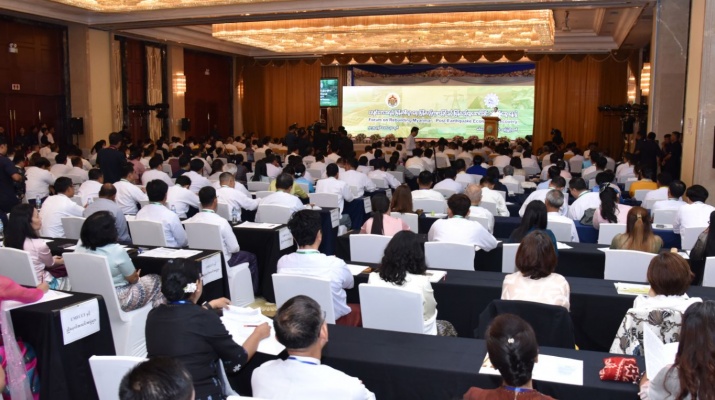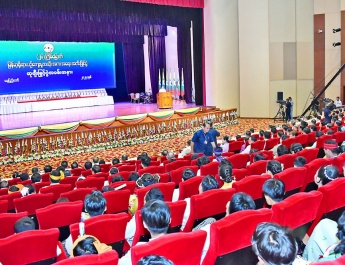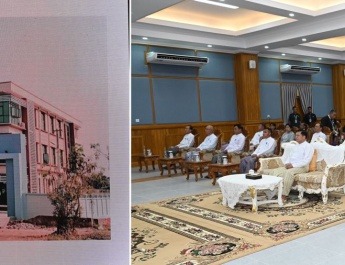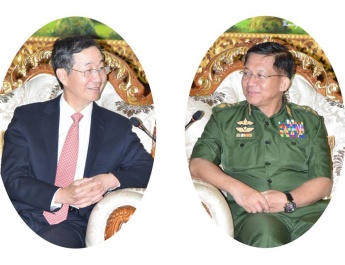NAY PYI TAW May 30
Forum on “Rebuilding Myanmar: Post Earthquake Economic Recovery” was launched at Mingala Thiri Hotel here this morning, and Chairman of State Administration Council Prime Minister Senior General Min Aung Hlaing delivered the opening address.
Also present were SAC Joint Secretary General Ye Win Oo, SAC members, union level dignitaries, union ministers, senior military officers from the Office of the Commander-in-Chief, deputy ministers, the chair and officials of Myanmar Narrative Think Tank and Union of Myanmar Federation of Chambers of Commerce and Industry, diplomats, representatives from political parties and civilian organizations, economists, officials of associations and organizations and guests.
The opening ceremony was honoured with the song “Rehabilitation.” Then a video clip on “Rebuilding Myanmar: overcoming post-earthquake hard-ships and identifying economic opportunities” was screened.
The Senior General and attendees observed a minute silence for the persons who died in the Mandalay earthquake. In his opening address, the Senior General said :Today’s forum is held with the three objectives: restore and strengthen businesses damaged by the earthquake, find out new internal and external markets, opportunities that may further improve national economy and possible challenges, and extend markets for the country’s ex-ports through the application of geopolitical landscape and geoeconomic opportunities and promoting cooperation among entrepreneurs.
Due to the Mandalay earth-quake 3,739 lost their lives while 5,104 others were injured with 68 people still missing. As the damage caused by the earthquake was very severe, I took immediate action, re-questing domestic and foreignrelief assistance. In response to my request, 21 nations have sent 3,109.317 tons of relief sup-plies, relief workers numbering 1,070, health care technicians and the doctors numbering 287 for conducting relief activities.

A total of 26 nations have sent relief workers and aid via all three modes of transportation–air, sea and soon after the earthquake occurred. On behalf of the government and the people of Myanmar, I would like to express my heartfelt thanks to the governments and the organizations from the nations, the domestic and foreign well-wishers and the relief workers who have provided help in carrying out Mandalay earthquake relief activities. As you are all aware, Mandalay earthquake has adversely affected the socio-economic conditions of the people. According to the calculations, it cost Ks-3,629.208 billion in losses. So, we are taking rehabilitation measures with greater momentum.
The forum will seek suggestions via discussions from the socio-economic perspective with national and international experts as well as with those entrepreneurs from respective sectors who have suffered in order to find out how we can remedy the economy damaged caused by Mandalay earthquake and how we can have economic recovery and what opportunities will be available from the said remedial and rehabilitating measures. We gather here today not to demonstrate our grief over our substantial losses but to seek ways to survive like the phoenix the country will rise again. More importantly, it is required to discuss in an amicable manner based on patriotism and unison.
The earthquake has not only caused physical damages in transport and communication and energy sectors but also adversely affected the socio-economic lives of the people. Some people perished whereas others were forced to leave their homes and stay in temporary shelters. Those who have survived the earthquake are suffering from trauma with our path to development affected to a certain extent. Nonetheless, we have demonstrated our resilience. I would like to assert that the catastrophic earth-quake could not destroy our united strength.
And I would like to emphasize that today’s forum is not only a venue for the talk show but for laying down the foundation for achieving a roadmap. In this juncture, I would like to deal with the three strategic pillars which ought to be erected on the basis of our views in our endeavour to remedy the economy in the post-earthquake era.
The first pillar is concerned with humanitarian aid and social protection whereas the second and the third pillars are related to infrastructure reconstruction and economic revival and reform anchored in resilience and inclusivity correspondingly.
May I commence from the first pillar i.e. humanitarian relief and social protection. As soon as we were hit by the earthquake, our priority was naturally to save the lives of the people and restore the stability of the social community. The governmental organizations, the regional authorities, the civil society organizations and the international partner organizations have cooperated substantially in providing humanitarian assistance on a large scale, and are still doing the same. Still, it is required to accelerate the relief and rehabilitation activities.
The disastrous earthquake has had a direct impact upon 600,000 people or so with thou-sands of people having been forced to move out of their places. In the worst hit areas, emergency tents were erected within 72 hours of the outbreak of the earthquake. Safe water, food and medicines were pro-vided. Concerning healthcare, mobile hospitals and clinics were opened in the earthquake-stricken areas to provide health-care to the people stricken by the earthquake. Additionally, those who have survived the earthquake particularly the children and the aged are pro-vided with counselling sessions to mitigate their mental trauma.
Notwithstanding, providing humanitarian assistance does not end with mitigation. This type of assistance should be integrated into the social protection system. This is the reason why we are taking such following measures as construction of earthquake resistant buildings for permanent abodes, arranging for sending the displaced children to the safe and secure schools and classrooms and providing monetary assistance to those families who have lost their main income. This can be said to be part of the social protection system. This being so, the first pillar is directed towards the affairs of the people.
As mentioned above, the second pillar is concerned with infrastructure reconstruction and economic revival. The amount of losses in the economic sector caused by the earth-quake accounts for astronomical figures. The roads were badly damaged and the bridges collapsed. Commencing from MSMEs to factories and work establishments as well as big enterprises, the earthquake has damaged them all.
We ought not to forget however the fact that there can be opportunities amongst the difficulties. Now is not the time of mere reconstruction, for we have opportunities to rebuild a better, greener social environment. We have to formulate a national-level rehabilitation program and implement it systematically through construction of resilient infrastructure. And this program should incorporate raising of national funds, public-private partnerships and inter-national aid. And rehabilitation should be focused on the five main areas: transport; energy; agriculture; telecommunications; and public buildings.
While rebuilding the infra-structure, we should focus on the revival of the MSMEs which can be said to be the backbone of the economy of Myanmar. It is hoped that we can rebuild the trust of the investors through earthquake rehabilitation activities. Convening of international investment and rehabilitation forum will do the job. Such fora will attract the investors via establishing of the recovery zones, providing of privileged incentives and the ESG-focused regulations under which the procedures for environmental conservation, social environment development and good governance can be formulated.
With regard to the third pillar i.e. reform and global partnership, rehabilitation shall go beyond the physical rehabilitation. Rehabilitation should be extended to include reform and reconstruction. In doing so, we ought to conduct three long-term approaches: preparedness for the natural disasters inclusive of earthquakes; financial accountability; and comprehensive development.
When it comes to disaster preparedness, we should draw an updated national disaster map indicating the high-risk locations. Early warning systems shall be installed. The relief process should be redesigned with the use of modern technology.
Concerning financial accountability, allocation of the rebuilding funds shall be transparent. Furthermore, a monitoring mechanism shall be established to rid losses and wastes as well as to effectuate development.
With regard to the third approach i.e. comprehensive development, development shall be effectuated to include the women, the ethnic minorities and the entire mass of the people.
When we implement the recovery activities, we need to join hands with the international and regional partners. I am of the view that it is indispensable to formulate the short-term, medium-term and long-term arrangements to rebuild in the post-earthquake era and implement them in cooperation with ASEAN members and the countries within the region, the neighbours and also with the regional and international organizations. Rebuilding means not only repairing the damaged buildings and making an effort to ensure economic recovery but also building of a secure and safe nation in the future where there shall prevail strong infrastructure, accountable governance and equal development.
We want the support of the regional and international partners. And we also want to invite them to invest in the new vision of Myanmar. We are determined to create a stronger, more united and more inclusive nation in future. This is something we must do.
Our people have displayed their courage, unity and diligence in carrying out the earthquake relief activities. I would like to honour them as I regard them as the national assets or the national capital. In our long march towards national rehabilitation, our people are the guiding light. In the face of various hardships, we were united, working together in unity. I would like to urge them all to overcome the hardships by sticking to the motto, “We are stronger, we are together.”
The results that will yield from this forum will contribute dramatically towards shaping the future of Myanmar. I would like to urge you to ponder over the ways and means to enable embodiment of the ideas, knowledge and the resultant points in formulation of the economic development strategy for Myanmar in order that we can build a brighter, more beautiful Myanmar.
In his supplementary discuss-ions, the Senior General said after SAC assumed the responsibilities of the State, it had to overcome COVID-19, apart from the consequences of climate change. It had also overcome disturbances resulting from disagreements in early 2023. It is still overcoming the hardships internal armed conflicts had created.
The country faced inundations due to heavy rains caused by cyclone Mocha in 2023 and typhoon Yagi in 2024. In March 2025, the Mandalay earthquake triggered heavy losses and they were worse in certain areas in the Mandalay Region. The region is the second lar-gest economy of the country. Medium-scale cement and steel mills were destroyed by the earthquake. As cement is an essential element of the construction industry, the government made arrangements for their earliest restoration. It has to control the rising cement prices. As the country cannot produce enough steel rods for the industry, help from other countries is being sought.
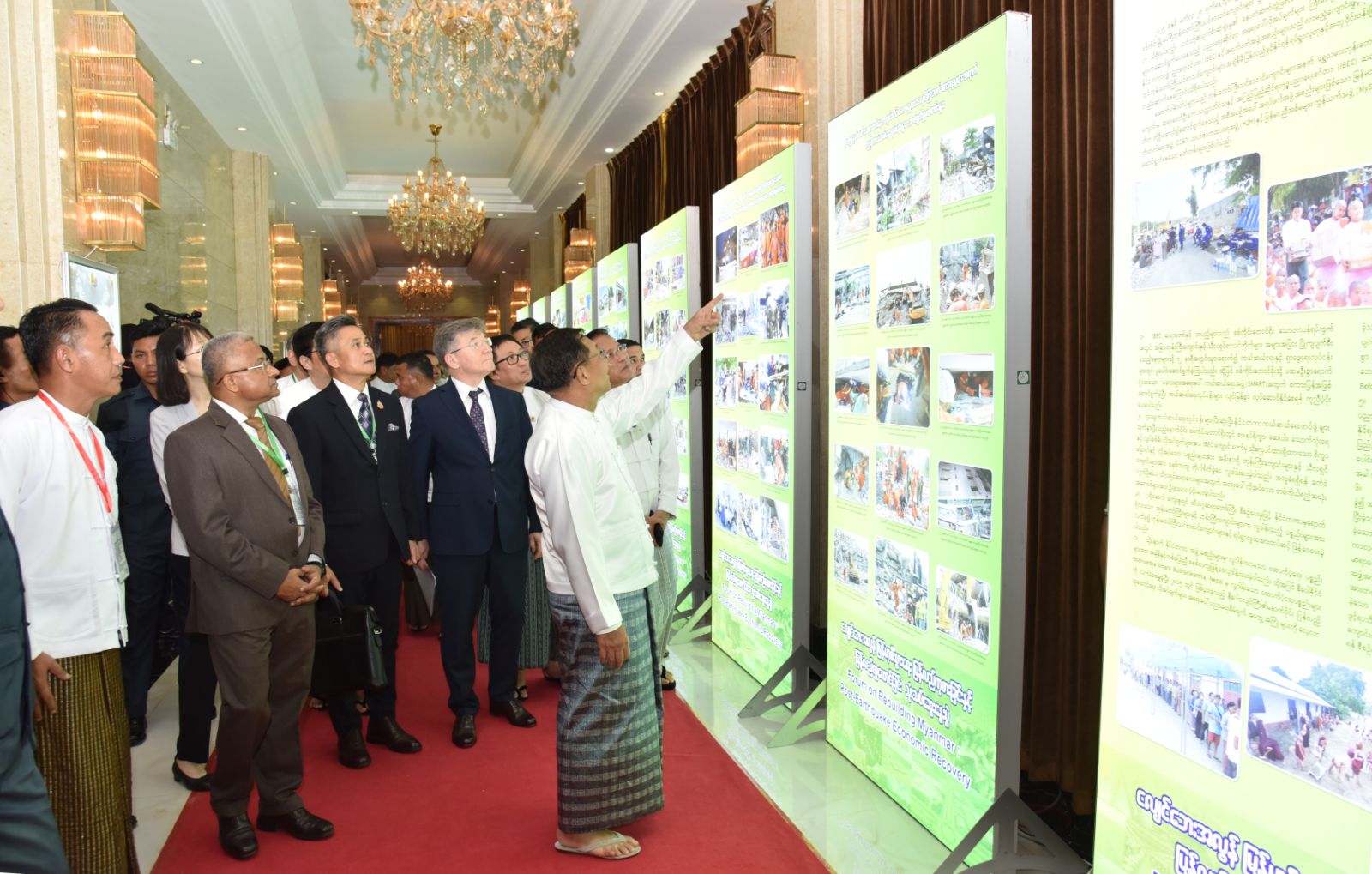
Industries need raw material and inputs such as fuel, electricity and capital and labour. The Senior General always urges MSME entrepreneurs to rely on local raw materials. If local factories can boost production, there will be plenty of consumer goods in the country. Operating factories generate jobs and money circulation, followed by a rise in supply and demand. Hence, healthiness of businesses and money circulation is a must, and greater attention must be paid to Mandalay Region, the second largest pro-duction area of the country.
The GDP of our country remains low, and increasing the production and export of goods, both domestically and inter-nationally, would lead to higher foreign exchange earnings. In the 2024-2025 fiscal year, trade recorded a surplus of approximately 2.3 billion, but non-trade activities showed significant deficits. During the four years of our government’s tenure, the first year saw a trade surplus, while the second and third years recorded trade deficits. In the fourth year, a trade surplus was achieved again, resulting in an overall trade surplus over the four-year period. However, deficits in non-trade activities have caused foreign exchange rates to rise. Upon investigation, it was found that a large number of citizens going abroad and excessive foreign spending are contributing factors. Therefore, to recover foreign exchange, factories and workshops must operate efficiently to produce and export more goods. Those managing factories and workshops are urged to enhance production and operations. Our economic policy is: “If the quality is the same, the price must be lower; if the price is the same, the quality must be better.” This approach will boost sales in the market. Increased production and sales volumes are necessary, and domestic products should also be promoted. Non-trade deficits include illegal imports and illicit trade. Excessive importation of foreign goods has been observed, and efforts should be made to replace these with domestically produced goods. For this reason, we are supporting MSME initiatives. Since around 2022, we have been promoting MSMEs, and currently, high-quality MSME products are being produced and distributed. However, most of these products are foodbased, and there is a need to further increase the production of MSME goods that can significantly contribute to the national economy.
Regarding investment funds, particularly in relation to earthquake recovery efforts, investment capital is required. Proposals have been made for public-private partnerships to facilitate loans. Interest rates will be divided into two categories: Developing and Commercial. For Developing projects, lower interest rates are needed, while Commercial projects will have two tiers one for earthquake affected areas and another for other regions. Where possible, interest rates should be kept affordable, and those responsible, along with experienced individuals, are urged to discuss and implement these measures. For earthquake-affected areas, we have allocated approximately Ks-700 billion for loans to support investment initiatives.
Regarding the National Eco-nomic Promotion Fund, we currently have a balance of approximately Ks-226 billion.
We aim to utilize these funds effectively and encourage their use in factories and workshops to ensure productive outcomes. Therefore, discussions should include how to efficiently allocate the National Economic Promotion Fund for these purposes.
For us, it is necessary to exert efforts for economic growth and on the other hand efforts must be made to lower the commodity prices. One of the means to do so is production, without which it is impossible to reduce commodity prices. First of all, we need to take measures to balance supply and demand and production and consumption. Therefore, it is necessary to boost production in respective regions. Ours is not a planned economy but a market-oriented one. The government will adopt policies only but private entrepreneurs must implement them. Only then, will commodity prices fall. Therefore, it is vital to boost production of foods and drinks and to try to meet yield targets of crops. As the country loses US$-8 billion to US$-11 billion revenue due to failures to meet targeted crop yields. Therefore, it is necessary to try to meet the capabilities to grow extra crops while livestock breeding tasks are systematically carried out. If we can do so, product-ion capabilities will increase and more quality products will be exported to other countries. Based on the geographical location of the country, participants are urged to discuss boosting production to fulfill the demand of large markets in neighbouring and regional countries.
In connection with rehabilitation, buildings, roads and bridges were damaged and it is necessary to take lessons from them. A policy has been adopted to construct future infrastructures that can withstand eight Ritchester scale earthquakes. It is for the future citizens of the country. Responsible officials are also required to supervise rehabilitation efforts systematically. In carrying out earthquake rehabilitation tasks, it is necessary to bear in mind that measures should be taken for safer and stronger investments than previous ones without considering its high costs. I would like to urge all to discuss what is necessary for post earthquake rehabilitation frankly at the forum.
Artistees of Fine Arts Department, the Ministry of Religious Affairs and Culture, sang the song “Resilient Myanmar.” The Senior General and attendees posed for documentary photos.
After the ceremony, they look-ed around a photo exhibition of damages caused by the quake and rescue, relief and rehabilitation undertakings.
The forum is being held for two days on 30 and 31 May with the objectives of restoring and strengthening businesses damaged by the earthquake, finding out new internal and external markets, opportunities that may further improve national economy and possible challenges, and extending markets for the country’s exports through the application of geopolitical landscape and geoeconomic opportunities and promoting cooperation among entrepreneurs.


